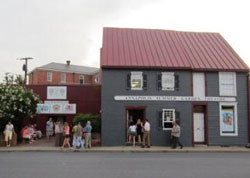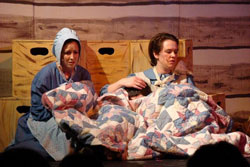About Us: Our History
In 1965, “Olde Town” Annapolis had been designated a Registered National Historic District, and restoration of many of its historic buildings was just beginning. The following year a group of arts enthusiasts, led by Joan Baldwin, incorporated Annapolis Summer Garden Theatre (ASGT) to give actors and theatre artists the opportunity to perform and ply their craft in the summer when other local groups were, generally, on hiatus.
Joan had been active with The Colonial Players and was a founder of the Chesapeake Appreciation Days and the Annapolis Fine Arts Festival. She was aided by a few friends and co-founders: Tony Maggio as the technical expert; Al Tyler as artistic director; and Ed Hartman as attorney.
In the summer of 1966, ASGT staged its first productions – “You Can’t Take It With You” and “Brigadoon” – outdoors under the stars behind the Carvel Hall Hotel. (At that time, the William Paca House was still encased by the hotel building and the gardens had not been excavated.)
By 1967, demolition of the hotel and site work for the Paca Gardens was continuing and the group began the search for a more permanent home. In a 1990 interview in “Annapolitan” magazine, Joan credited Ted and Marion Martens with identifying the abandoned Shaw Blacksmith Shop at 143 Compromise Street as a possible site for the new theatre. The last owner to use the site for commerce was the Shaw family, respected blacksmiths who moved their business to Parole in 1960. The building had been vacant for several years.
Joan was the visionary who led the effort to give the site a new identity and a new life. The building had been vacant since the early 1960s when the Board of Education acquired the site to build their new headquarters. (See About Our Theatre for details.) The Board’s plan was stalled by concerns from the historic preservation community, and so they rented the property to ASGT for $1 a year. The monumental work to turn the property into an outdoor theatre began, and ASGT’s second season was staged at the Compromise Street site that we still occupy.
Joan recruited board members and sponsors from many sectors of the community. At the time, many felt that bringing new life to the historic district was a civic duty. Joan was the first president and served on the Board until 1969. By then, however, ASGT was firmly established and had presented four seasons of “theatre under the stars.”
Readying the site for the first season took not only imagination, but a lot of labor. The building had been vacant and was inhabited by more than a few critters. Many truckloads of dirt, old horseshoe nails and other debris were carted away. When they were readying the theatre for the first performance, the volunteers were dismayed by the dirt and mud in the house area where the audience would sit. Local business man Paul Pearson donated sod, and suddenly the theatre looked like a garden. The sod did not hold up to the foot traffic and the folding chairs, so a few years later the sod was replaced with gravel.
The fledgling group realized almost immediately that staging theatre outdoors presents many challenges. Rain is but one of those. Street noise from cars and motorcycles has always been a challenge, but one that our actors can surmount. Noise from boat engines and boat horns is probably unique to ASGT, but we are, after all, across from the City Dock. And then there are the bugs. Mosquitoes are no longer the problem that they were in the early years, but many of us witnessed the event when a moth, probably attracted by the lights, flew right into the open mouth of an actor in mid-song. We also remember the opossum who wandered across the stage during intermission. It was early in the season and she moved on when our noise did not subside. The summer heat is harder on the actors than the audience, but it is summer. That’s what we expect.
Ellen Moyer followed Joan as the second president of ASGT, and by 1971, the theatre had hired Roland Chambers as the artistic director. He had toured nationally and performed in the Washington-Baltimore region. He was an accomplished actor, director, artist, set designer and set builder. At ASGT, he directed the bicentennial production of 1776 which was critically-acclaimed and which ran all of 1975 and half of 1976. His abilities and his exacting standards are still well-known in the artistic community. Several of the actors who performed in our 40th Anniversary production in 2006 credit Roland with instilling the spark that led to their love for performing.
We could never name all of the people who had a significant impact on the ASGT organization. There are many and we would, undoubtedly, miss some. In 42 years, there have been more than 5,000 board members, directors, actors, and other volunteers who have left their mark on ASGT.
Over the years, the organization faced a number of challenges. In 1973, we feared losing our lease on the Shaw Blacksmith Shop. The Board of Education decided that they couldn’t build their headquarters on the site and they were disposing of the property. The disposal was handled by the State of Maryland, and Anne Arundel County acquired the property. The County had no immediate plans for the site and allowed ASGT to remain. We signed a new lease for $1 a year. By the mid-1980s the property needed many repairs that could not be funded with seasonal revenues. We could not borrow money to fund the repairs because we did not own the building. County Council member Maureen Lamb intervened on our behalf and introduced a bill to transfer the property to ASGT. It was supported by the Anne Arundel County administration. After several years of negotiations with groups interested in our maintaining the historic integrity of the building and property, a County Council bill was passed and we became the owners of 143 Compromise Street in 1990.
Over time we’ve tinkered with the formula for a successful summer season. In 1985, 1986 and 1987, we staged adult productions with many roles for young people. Some of the adults became interested in doing something to keep the young people involved in ASGT. Over a period of months, they developed the idea for a separate youth production that was ultimately named The Talent Machine. Mike Gilles and Steve Evans wrote the first script with ideas contributed by Sue Centurelli, Jill Compton and Bobbi Smith. Bobbi took the script and developed it further and the first production of The Talent Machine was staged at ASGT in the summer of 1988. The shows ran Monday through Wednesday, when the adult shows were dark. Variations of the original script were produced by ASGT for six summers, until 1993. Bobbi then moved the production to St. John’s College and The Talent Machine Company became an independent group. We staged four more weeknight youth productions from 1994 through 1997, before deciding that staging shows seven nights a week took too great a toll on our volunteers and our facility.
In 1998 we again changed our season formula, adding a third weekend show and shortening all the runs to five weeks. For the next eight years, our middle show was a play by William Shakespeare. Since 2006, all three shows have been musicals. We will continuously assess the interests of our audience and schedule seasons with the widest appeal.
The ASGT organization continues to evolve and we welcome new volunteers each year. Under "About Our Theatre" there is information about our Stage/2 building project. We anticipate that the organization will be revitalized by this exciting project to restore and renovate our wonderful “theatre under the stars.”
|













